In the 1920s, women's fan purses emerged as stylish accessories that blended practicality with artistic flair. These unique pieces mimicked traditional hand fans, crafted from luxurious materials like silk and embellished with intricate beading and lace. Their compact design was perfect for social outings, reflecting the vibrant Art Deco style of the era. More than mere fashion statements, these purses symbolized women's newfound autonomy and individuality during a cultural shift. With various iconic brands producing elaborate designs, fan purses became highly sought-after collectibles. Discovering the variety of styles and manufacturers reveals even more about their fascinating history.
Overview of Women's Fan Purses
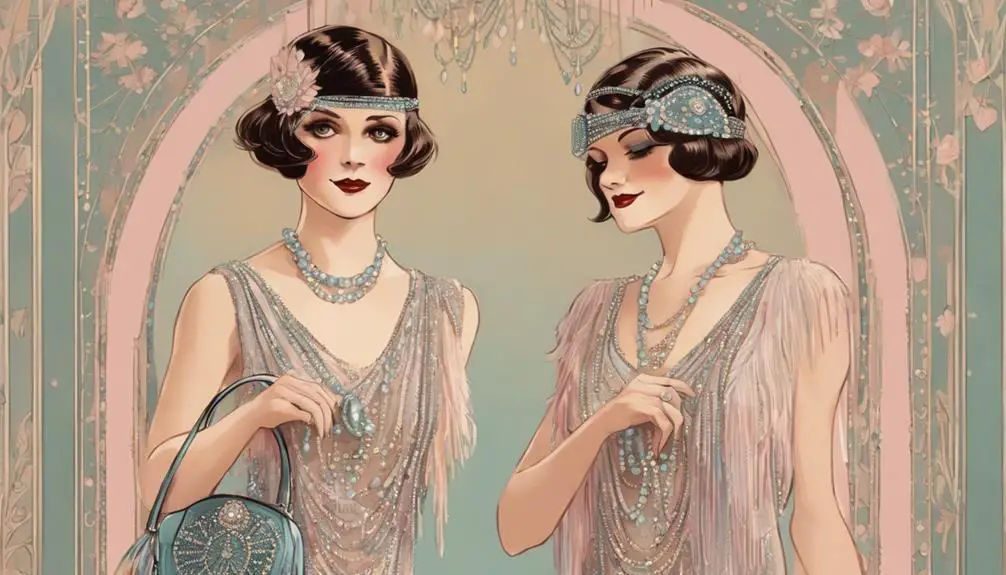
In the vibrant landscape of the 1920s, women's fan purses emerged as both a practical accessory and a statement of style, seamlessly blending functionality with artistic flair. These unique evening bags were often designed to mimic traditional hand fans, crafted from materials like silk and lace, and adorned with beads or sequins. The compact size of the fan purse made it perfect for carrying essentials during social outings, aligning beautifully with the flapper attire that defined the era.
Reflecting the bold Art Deco style, fan purses showcased geometric patterns and vibrant colors that captured the essence of the Roaring Twenties. This period marked a significant cultural shift, where women embraced newfound independence and social freedom. The fan purse not only served as a stylish accessory but also symbolized autonomy, allowing women to express their individuality.
Many fan purses featured functional elements, such as small compartments and kiss-lock closures, ensuring safe storage for lipstick, coins, and other personal items. This combination of practicality and decorative art made the fan purse an essential item for women of the time, embodying the spirit of an era that celebrated both elegance and empowerment.
Design Characteristics of Fan Purses
Women's fan purses of the 1920s stand out for their distinctive design characteristics that reflect both the artistic trends of the era and the practical needs of their users. These purses, often resembling a hand-held fan, featured intricate embellishments like beading, silk, and lace that embodied the Art Deco aesthetic. The foldable or pleated structure not only added decorative appeal but also enhanced functionality, allowing you to carry essential items.
The design included elaborate closures, such as kiss locks or metal clasps, which contributed to their elegance while ensuring secure storage. Colorful patterns and motifs—drawing inspiration from nature, geometric shapes, and cultural influences—made each purse a unique statement piece.
| Design Element | Description | Impact |
|---|---|---|
| Shape | Hand-held fan-like with pleats | Combines style with utility |
| Embellishments | Beaded, silk, and lace detailing | Reflects era's glamour |
| Closures | Kiss locks and metal clasps | Provides security and charm |
Fan purses served not just as evening bags but also as symbols of social status among flappers and fashionable women during the vibrant nightlife of the 1920s.
Popular Materials Used
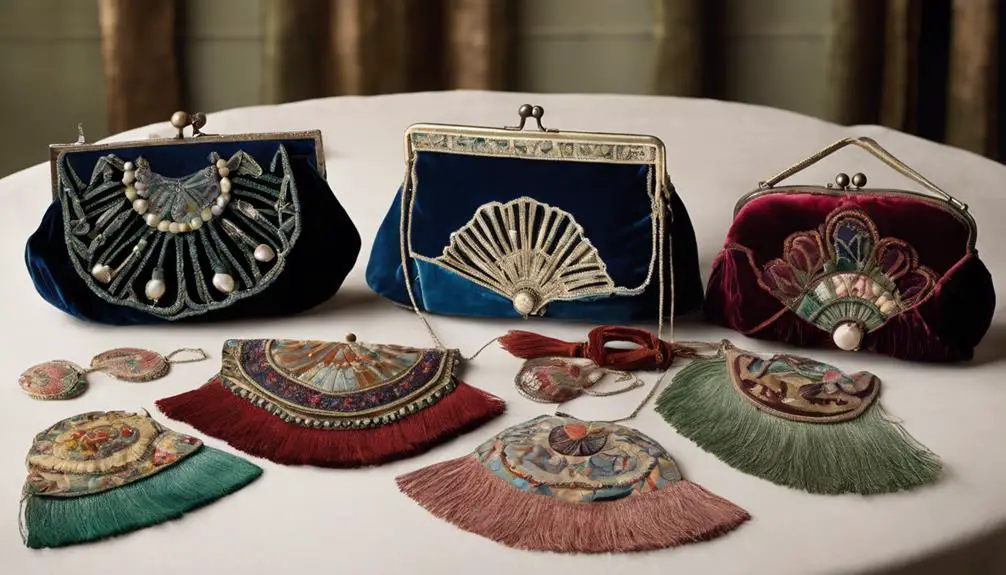
What materials did the iconic fan purses of the 1920s utilize to embody the era's lavish style? The fan purses, emblematic of the Purse Art Deco movement, often featured luxurious fabrics like silk, velvet, and beaded materials. These choices not only reflected the opulence of the time but also added to the visual allure of evening wear. The intricate embellishments—sequins, embroidery, and fringe—transformed these bags into stunning accessories, elevating any outfit.
You'd notice that durability was also a key consideration, with leather emerging as a favored material. This choice offered a classic aesthetic, ensuring that the purses were both stylish and practical for social events. Additionally, the lightweight nature of these materials allowed for ease of carrying, which was essential for women looking to maintain their elegant appearance while mingling.
Some fan purses incorporated metal mesh and chain elements, lending a touch of glamour that resonated with the burgeoning trends of the decade. Overall, the materials used in these purses weren't just about function; they were integral to the identity and allure of women's fashion in the 1920s.
Cultural Significance in the 1920s
The cultural significance of fan purses in the 1920s goes far beyond their aesthetic appeal; they epitomized a transformative era for women. These evening purses, often adorned with intricate beading and embellished fringe, reflected the Roaring Twenties' fascination with glamour and sophistication. As you navigate the vibrant social scene of the era, you'll notice that these unique accessories served not just as functional items but as bold statements of style and social status, aligning perfectly with the flapper culture that embraced daring fashion choices. The craftsmanship involved in creating these purses mirrored the high-quality materials and distinct tailoring techniques found in authentic vintage pieces, underscoring their value as collectibles in the world of vintage clothing labels.
The Art Deco designs commonly found on fan purses, characterized by geometric patterns and vivid colors, symbolize the artistic movements of the time. As jazz music thrived and nightlife flourished, fan purses became essential companions for women attending parties and social events, enhancing their evening attire. More importantly, these purses represented a shift in societal norms, allowing women to express their individuality and confidence in public spaces. By carrying an embellished fringe bucket bag, you weren't just accessorizing; you were making a statement about your independence and liberation in a rapidly changing world.
Iconic Brands and Manufacturers
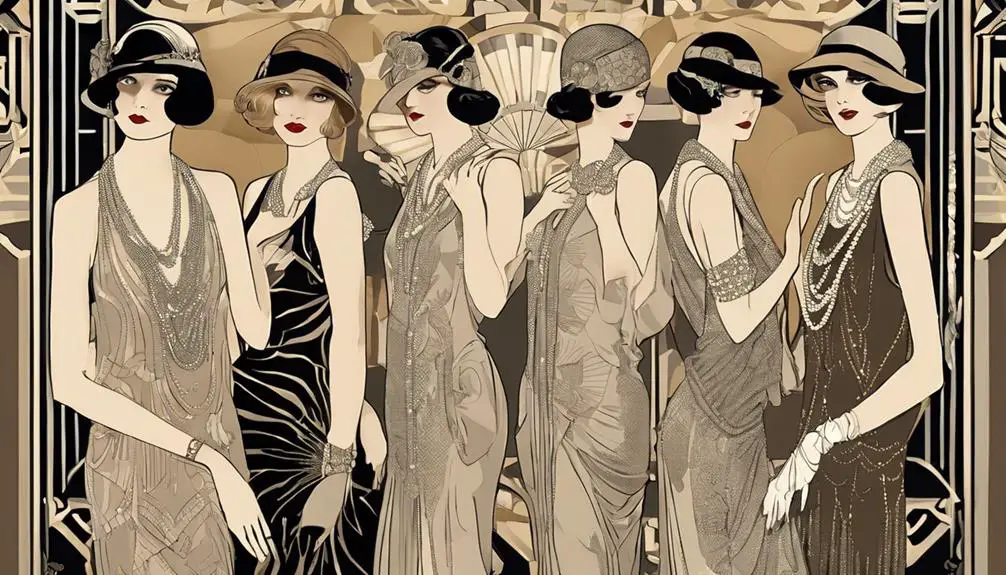
During the 1920s, a select group of brands and manufacturers emerged as leaders in the production of fan purses, each contributing to the era's distinct aesthetic and cultural narrative. Remarkably, Whiting & Davis gained fame for their luxurious mesh and beaded bags, epitomizing the Art Deco style that defined the decade. Their intricate designs not only showcased craftsmanship but also reflected the opulence of the Jazz Age.
The Mandalian Manufacturing Company stood out with its ornate mesh purses, often adorned with vibrant colors and complex patterns that perfectly captured the essence of flapper fashion. Meanwhile, manufacturers like Evans and Justin Leather Goods diversified the market by introducing evening bags made from materials such as chainmail and leather, appealing to women's desire for both style and durability.
Vintage brands like Judith Leiber emerged as key players, known for extravagant evening bags featuring artistic designs and premium materials. These iconic brands not only shaped fashion trends but also sparked a collector's interest, with rare pieces from Whiting & Davis fetching high prices at auctions, underscoring their historical significance and unique appeal in today's vintage market.
Evolution of Evening Bags
As fashion evolved through the 1920s, evening bags transformed from mere practical accessories into lavish statements of style and sophistication. You'd find that these bags, such as the hand embellished fringe bucket and various beaded purses, became essential for completing an elegant evening look. Their designs reflected the bold spirit of the decade, influenced heavily by the flapper culture and the Art Deco movement.
You'd see evening bags crafted from luxurious materials like silk and leather, adorned with intricate beadwork, geometric patterns, and vibrant colors that captured the essence of the era. Key styles included pouchettes and clutches, which not only served a functional purpose but also showcased personal style and social status.
The introduction of features like chain straps and kiss lock closures made these evening bags practical for formal events, enhancing their appeal. As you navigated the nightlife of the 1920s, these bags became more than mere containers; they symbolized a woman's liberation and her desire to express individuality. Consequently, the evolution of evening bags marked a significant shift in fashion, merging utility with artistry in a remarkable way.
Differences Between Fan Purses and Clutches
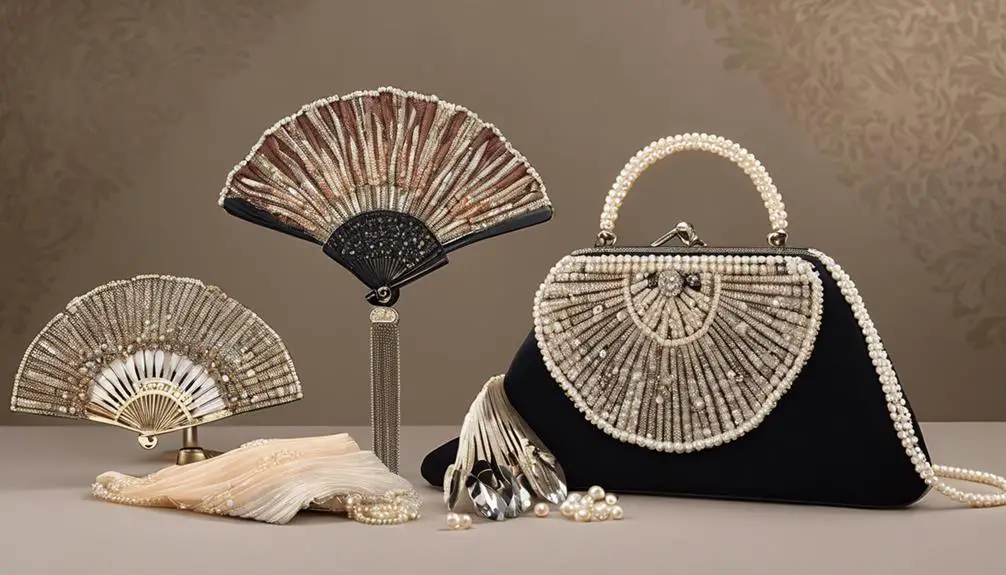
Evening bags in the 1920s showcased a variety of styles, with fan purses and clutches standing out as two popular options. While both bags served the purpose of carrying essentials, their designs and uses differed considerably. Fan purses, often crafted from delicate materials like silk and lace, feature a unique fan shape that opens and closes like a folding fan. In contrast, the clutch bag is typically rectangular or square, designed for handheld use without a strap.
The table below highlights key differences between fan purses and clutches:
| Feature | Fan Purses | Clutch Bags |
|---|---|---|
| Shape | Fan-shaped | Rectangular/Square |
| Material | Fabric, lace, and embroidery | Leather, metal, simpler |
| Functionality | Decorative accessory | Primarily functional |
| Style | Theatrical flair | Minimalistic |
| Popularity Era | Flapper movement | Timeless elegance |
While clutches focus on functionality, fan purses serve as a vintage fashion statement, enhancing evening attire with their decorative elements. So whether you choose a fan purse or a clutch bag, each offers a unique expression of style from the roaring twenties.
Collecting Vintage Fan Purses
Collecting vintage fan purses has become an intriguing pursuit for fashion enthusiasts and collectors alike, particularly those captivated by the elegance of the 1920s. These bags, often made from silk, lace, or intricate beaded fabrics, are not just accessories; they're reflections of an era defined by Art Deco aesthetics and the spirited flapper culture. You'll find that many fan purses are embellished with sequins, embroidery, or painted scenes, transforming them into artistic statement pieces that stand out in any collection.
The appeal of vintage fan purses lies in their unique designs and craftsmanship, which can command prices ranging from $50 to several hundred dollars based on age, condition, and rarity. As interest in 1920s fashion continues to grow, so does the market for these collectibles. Online auctions and antique shows provide excellent venues for you to discover and acquire these treasures.
When you consider adding a coin purse or embellished fan purse to your collection, remember that each piece tells a story. The craftsmanship and artistry encapsulated in these bags made during the 1920s offer a tangible connection to a vibrant past, making them invaluable for any discerning collector.
Care and Preservation Tips
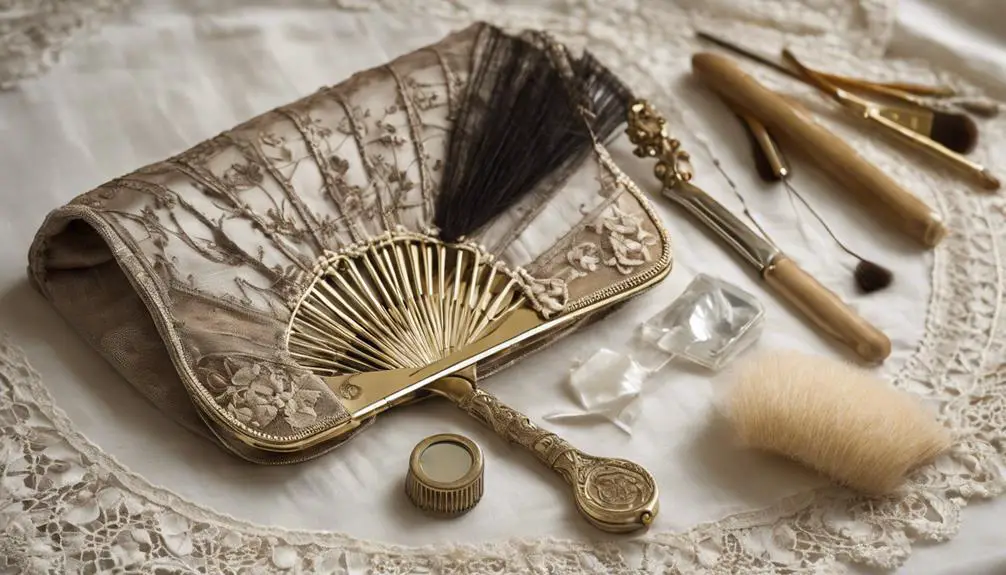
Preserving the beauty and integrity of vintage fan purses requires thoughtful care, particularly given their delicate fabrics and intricate embellishments. Start by storing your purses in a cool, dry place and away from direct sunlight to prevent fading and damage. This is especially essential for those made from delicate materials. Regularly inspect your fan purses for signs of wear, like loose beads or frayed edges, and address these issues immediately to avoid further deterioration.
When it comes to cleaning, use a soft, lint-free cloth to gently wipe away dust and dirt. Avoid harsh chemicals, as they can harm the materials. For beaded or embellished purses, consider placing them in a padded storage bag or box to protect them from crushing, maintaining their shape and elegance.
If your purse features a leather component, take special care to condition the leather periodically to prevent it from drying out or cracking. Additionally, if there are metal frames or components, polish them with a suitable metal cleaner to prevent tarnishing and keep their shine intact. With proper care and preservation, your vintage fan purses can continue to be cherished pieces of history.
Modern Interpretations and Trends
Modern interpretations of women's fan purses have taken a fascinating turn, blending the elegance of the 1920s with the demands of today's fashion landscape. These modern designs often marry vintage aesthetics with contemporary materials, appealing to both nostalgia and practicality. Here are three standout trends:
- Sustainable Materials: Many brands now utilize vegan leather and sustainable fabrics, making these purses eco-friendly choices.
- Intricate Design Elements: The classic shapes are preserved, featuring intricate beading and Art Deco patterns, reminiscent of the iconic styles once popularized in the Edwardian handbag era.
- Multifunctionality: Today's fan purses, including chic brown leather purses, often come with detachable straps and multiple pockets, satisfying the practical needs of modern consumers without sacrificing their vintage charm.
With millennials and Gen Z driving a resurgence of interest in 1920s fashion, fan purses have become trendy accessories for themed events and daily wear. Retailers cater to diverse budgets, offering affordable replicas around $20 alongside high-end designer versions that can exceed $200. This blend of charm and utility makes fan purses a collectible staple in contemporary wardrobes.
Frequently Asked Questions
What Bags Were Popular in the 1920s?
In the 1920s, you'd see clutch purses, pouchettes, and reticules dominating women's fashion. These bags showcased luxurious materials and intricate designs, reflecting the era's opulence while serving practical needs for social events and evening outings.
What Was the Women's Fashion in the 1920s?
In the 1920s, you'd embrace bold, liberated styles—shorter hemlines, relaxed silhouettes, and vibrant fabrics. Flapper fashion defined the era, featuring dropped waistlines, elegant accessories, and a nod to emerging Hollywood glamour, reflecting changing societal norms.
Why Were They Called Flappers in the 1920s?
You'll find that women were called flappers in the 1920s due to their rebellious spirit and fashion choices, symbolizing freedom from traditional constraints. Their lively attitude and bold styles transformed societal norms and expectations for women.
What Did a Flapper Look Like in the 1920s?
You'd see flappers in straight-cut dresses with dropped waists, embracing shorter hemlines. Their androgynous silhouettes, paired with cloche hats, bold makeup, and stylish footwear, embodied a liberated spirit, challenging traditional fashion norms of the era.
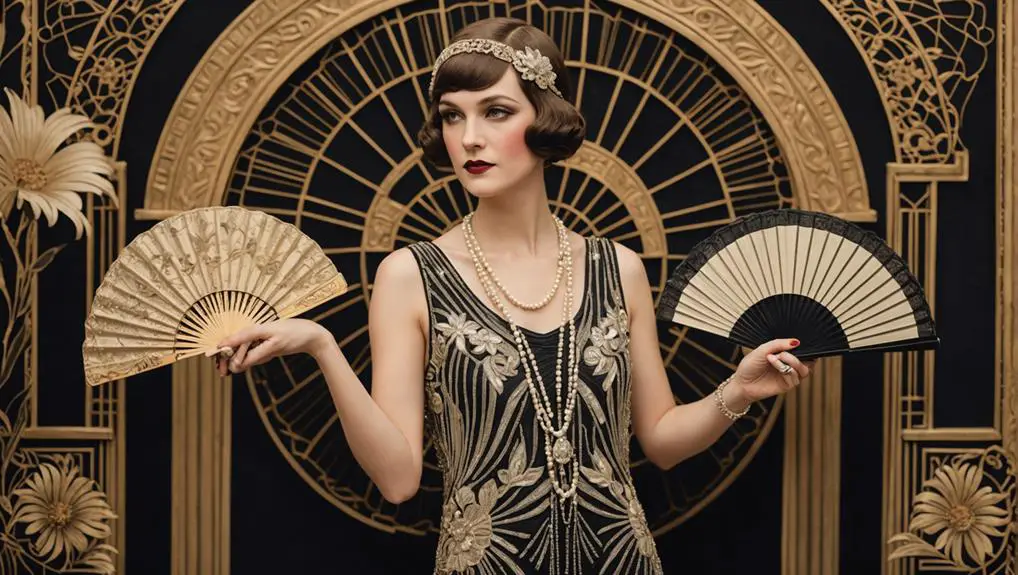


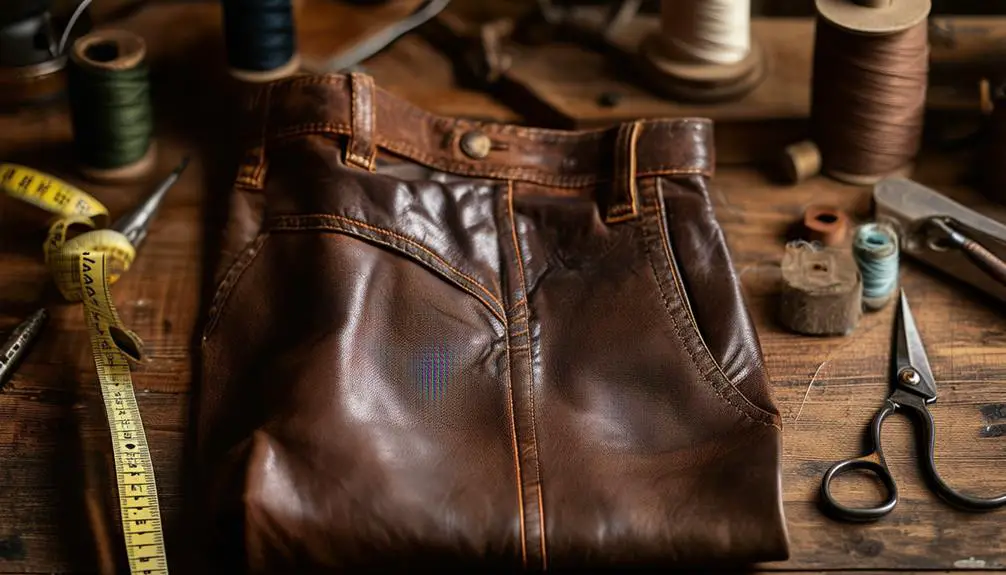
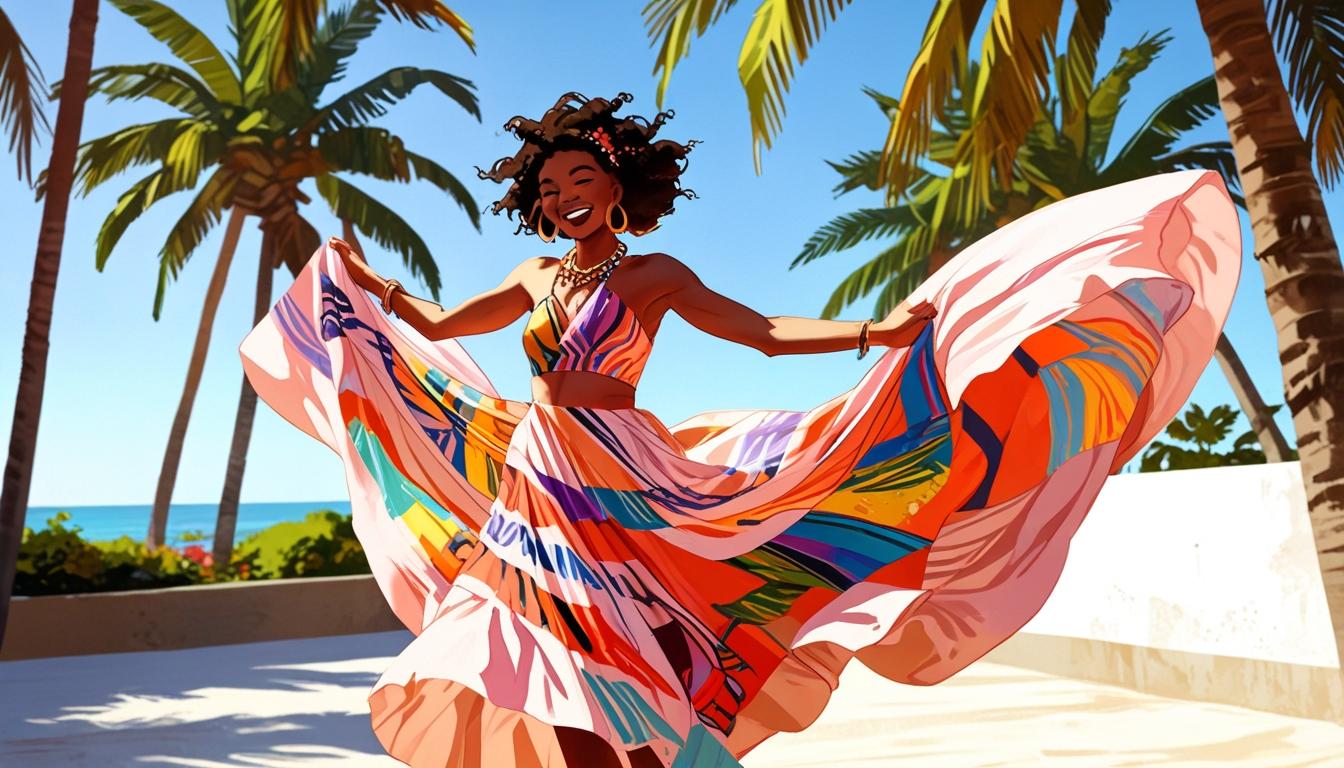
What’s Happening i’m new to this, I stumbled upon this I’ve discovered It positively
helpful and it has aided me out loads. I’m hoping to give
a contribution & aid different customers like its aided me.
Good job.
casino en ligne francais
Now I am going away to do my breakfast, after having my breakfast coming again to read more news.
casino en ligne France
Amazing blog! Do you have any tips and hints for aspiring writers?
I’m hoping to start my own blog soon but I’m a little
lost on everything. Would you recommend starting with a free platform like WordPress or go for a
paid option? There are so many choices out there that I’m completely overwhelmed
.. Any recommendations? Many thanks!
meilleur casino en ligne
Great weblog right here! Also your web site quite a bit up very fast!
What web host are you the usage of? Can I am getting your affiliate link on your host?
I wish my web site loaded up as quickly as yours lol
casino en ligne France
These are genuinely fantastic ideas in on the topic of blogging.
You have touched some nice things here. Any way keep up wrinting.
casino en ligne francais
Superb, what a blog it is! This web site presents useful
information to us, keep it up.
meilleur casino en ligne
Hi! Would you mind if I share your blog with my facebook group?
There’s a lot of people that I think would really enjoy your content.
Please let me know. Many thanks
casino en ligne
Hey there would you mind sharing which blog platform you’re using?
I’m looking to start my own blog in the near future but I’m having a difficult time making a decision between BlogEngine/Wordpress/B2evolution and Drupal.
The reason I ask is because your design and style
seems different then most blogs and I’m looking for something completely unique.
P.S Sorry for getting off-topic but I had to ask!
casino en ligne
Aw, this was an incredibly good post. Taking the time and
actual effort to generate a really good article… but what can I say… I put things off a lot and
don’t manage to get nearly anything done.
casino en ligne France
Definitely believe that which you said. Your favorite justification seemed to be on the
web the easiest thing to be aware of. I say to you, I certainly get irked while people think about worries that they
plainly don’t know about. You managed to hit the
nail upon the top and defined out the whole thing without having
side-effects , people can take a signal. Will likely be back to get more.
Thanks
meilleur casino en ligne